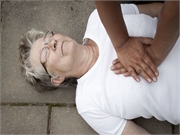Prepared Bystanders Save Lives When Cardiac Arrest Strikes

TUESDAY, Dec. 24, 2019 (HealthDay News) -- Few Americans survive cardiac arrest when it happens outside a hospital, but if more people knew how to recognize it and do CPR the odds might be better, a new study finds.
Only about 8% of those who suffer a cardiac arrest -- a sudden stoppage of the heart -- survive. Simply knowing what to do and doing it can increase the chance of survival, researchers say.
Three steps can save lives:
- Recognizing the signs of cardiac arrest -- loss of consciousness, no pulse or breathing -- and calling 911.
- Beginning cardiopulmonary resuscitation (CPR) using chest compressions. The American Heart Association (AHA) recommends using the steady beat of the classic disco song "Stayin' Alive" as a guide.
- Using an automated external defibrillator (AED) to deliver an electric shock to restart a victim's heart.
Bystanders should start CPR whenever someone is unresponsive and not breathing normally, the AHA advises.
"For every minute that a person with out-of-hospital cardiac arrest goes without CPR and defibrillation, the chance of survival decreases by 7 to 10%," Dr. William Brady, an emergency doctor at University of Virginia, wrote recently in the New England Journal of Medicine.
A 2010 review of more than 10,000 cardiac arrests found that 22% of patients who received bystander CPR survived, compared with 8% of those who didn't.
And a 2018 study of more than 50,000 cardiac arrests found that 67% of patients treated with an AED by a bystander survived, compared with 43% of those whose hearts were shocked after rescue crews arrived.
To improve survival odds, more people need to be trained, especially in CPR, the researchers said. Brady estimated that only about 2% of Americans a year get CPR training.
Efforts that might get more people to start CPR early include making training sessions shorter and using smartphone apps to alert trained people to a cardiac arrest near them, he suggested.
"The next major advance in cardiac arrest management is not a new hospital-based treatment nor fire-rescue intervention. It is this pre-arrival care performed by a bystander before fire-rescue personnel arrive and long before a patient is transported to the hospital. This care can allow victims of cardiac arrest to return to their lives and families," Brady said in a university news release.
More information
The American Heart Association has more on bystander CPR.

The news stories provided in Health News and our Health-E News Newsletter are a service of the nationally syndicated HealthDay® news and information company. Stories refer to national trends and breaking health news, and are not necessarily indicative of or always supported by our facility and providers. This information is provided for informational and educational purposes only, and is not intended to be a substitute for medical advice, diagnosis, or treatment.

